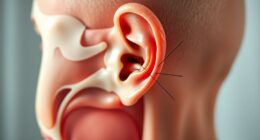A thorough hearing aid orientation covers how to use and care for your device, including its features, proper insertion and removal, and handling techniques. You’ll learn about battery management, troubleshooting common issues, and how to clean and maintain your hearing aids for maximum performance. Additionally, you’ll explore communication tips to improve conversations and discover support options for ongoing care. Keep going to uncover more important details to help you get the most from your hearing aids.
Key Takeaways
- Include training on hearing aid features, functions, and proper handling techniques.
- Cover battery management, replacement, and troubleshooting common technical issues.
- Educate users on recognizing sound distortions and when to seek professional support.
- Emphasize routine maintenance, ear health practices, and device cleaning procedures.
- Incorporate communication strategies, support resources, and follow-up care for ongoing assistance.
Understanding the Features and Functions of the Hearing Aid

Understanding the features and functions of your hearing aid is essential for maximizing its benefits. One key feature is frequency adjustments, which allow you to customize how your device amplifies different sound ranges, helping you hear speech clearly while reducing background noise. Noise reduction technology is another crucial function, designed to minimize unwanted sounds and improve overall listening comfort. When you learn how these features work, you can better tailor your hearing experience to different environments. Many hearing aids automatically adjust settings based on the surroundings, but understanding manual controls also helps you optimize performance. Familiarizing yourself with these features ensures you get the most out of your device, making communication easier and more natural in a variety of listening situations. Regular maintenance, such as filter replacement, is also important to sustain optimal performance and prolong the lifespan of your hearing aid.
Proper Insertion, Removal, and Handling Techniques
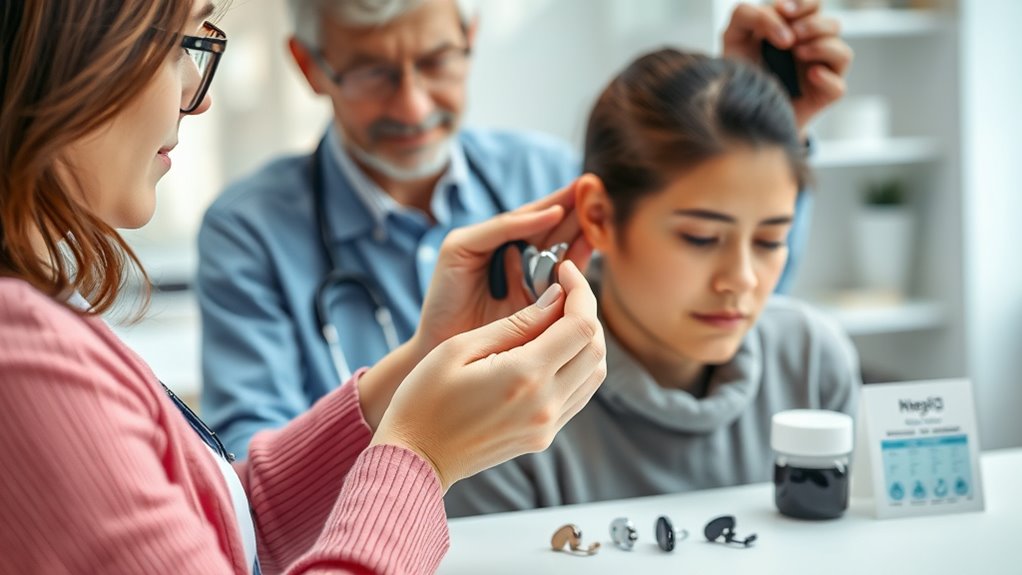
Learning the correct way to insert and remove your hearing aid helps guarantee comfort and performance. Handling your device properly reduces the risk of damage and keeps it clean. Let’s go over the key techniques for safe insertion, removal, and everyday handling. Paying attention to proper handling techniques ensures your device remains in optimal condition and functions effectively over time.
Correct Insertion Methods
Properly inserting and removing your hearing aid is essential for comfort and ideal performance. To guarantee correct ear canal placement, hold the hearing aid gently but securely. When inserting, use a slight downward and backward angle to follow the natural shape of your ear canal, reducing discomfort and improving sound quality. Make sure the earmold or dome enters smoothly without forcing it, which can cause damage or discomfort. Maintain a steady, controlled motion to prevent accidental injury or misplacement. When removing, do so gently, avoiding pulling or twisting. Proper handling minimizes damage and ensures the device functions properly. Practicing correct insertion angles and techniques helps you achieve a secure fit and optimal hearing experience while protecting your hearing aid. Additionally, regularly inspecting and maintaining your hearing aid, including cleaning and checking for damage, aligns with Wood Stove Safety First principles of proper maintenance and safety.
Safe Removal Procedures
To safely remove your hearing aid, approach it gently and with control to prevent damage or discomfort. Use your fingers to grasp the device firmly but carefully, avoiding sudden pulls that could cause removal hazards or hurt your ear. Always be mindful of ear safety—do not force the aid out if it feels stuck, as this could injure your ear canal. Instead, tilt your head or gently wiggle the hearing aid to loosen it before removal. Keep your nails short and clean to avoid scratching or damaging the device or your ear. Proper removal techniques help prevent damage to the hearing aid and reduce the risk of discomfort or injury. Remember, patience and gentle handling are key to safe and effective hearing aid removal. Additionally, being aware of the proper placement of the hearing aid can make removal easier and safer.
Proper Handling Practices
Handling your hearing aid correctly is essential for guaranteeing its longevity and your comfort. Always store your device in a proper storage case when not in use to protect it from dust, moisture, and damage. When inserting or removing your hearing aid, do so gently to avoid damaging components. Follow your practitioner’s recommended cleaning routines, which often include daily wiping and periodic cleaning of the earmold or dome. Proper handling also means avoiding exposure to water, extreme temperatures, and harsh chemicals. Be mindful of how you handle the device to prevent dropping or mishandling that could lead to costly repairs. Regularly maintaining and properly storing your hearing aid helps ensure ideal performance and extends its lifespan. Incorporating proper handling practices can significantly improve the durability and functionality of your device.
Battery Management and Maintenance
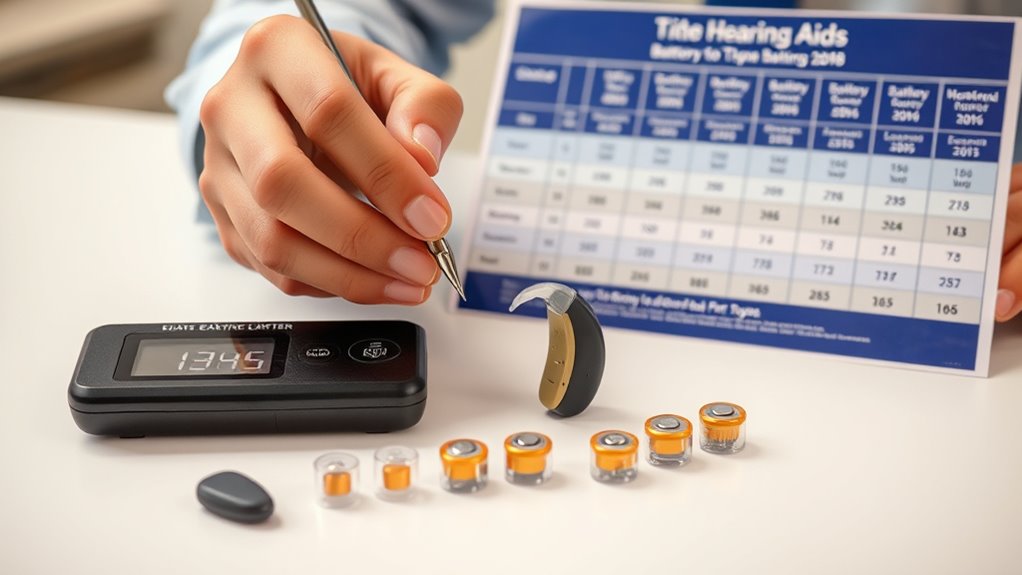
Are you aware of how crucial effective battery management is for your hearing aids? Proper handling can extend your battery’s lifespan and guarantee peak performance. To maximize battery life, follow good charging etiquette, such as opening the battery door when not in use and avoiding extreme temperatures. Keep spare batteries in a cool, dry place, and always check expiration dates. Regularly clean battery contacts to prevent corrosion and ensure a strong connection. Remember these key tips:
Proper battery handling extends hearing aid life and ensures peak performance.
- Use fresh, high-quality batteries
- Store batteries properly
- Turn off hearing aids when not in use
- Avoid exposing batteries to moisture
- Replace batteries promptly when depleted
- Being aware of battery types and their specific care needs can further improve your hearing aid performance.
Good battery management helps your hearing aids stay reliable and saves you money in the long run.
Adjusting Settings and Personalization Options
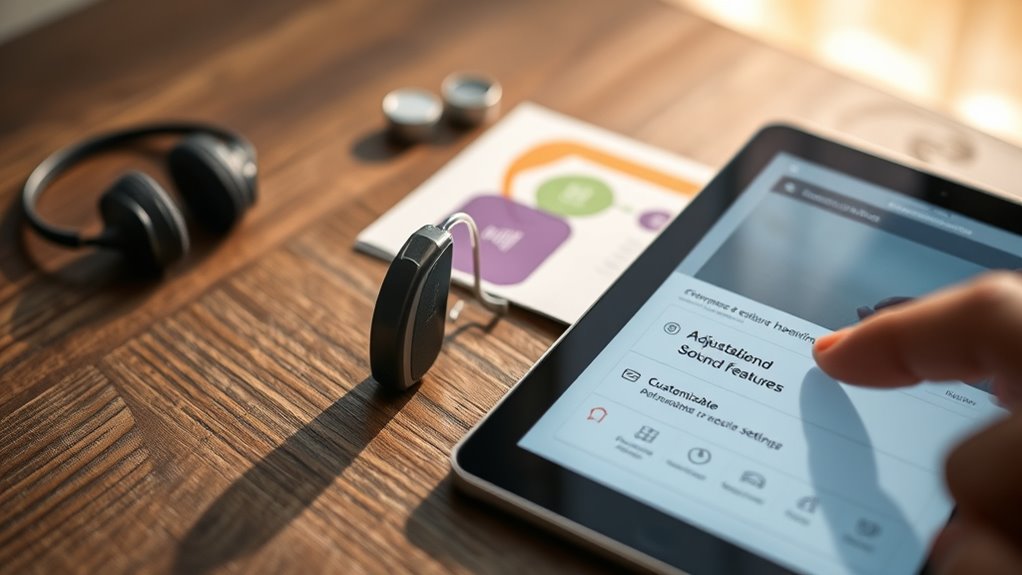
Adjusting the settings and personalization options on your hearing aids allows you to customize your listening experience for maximum comfort and clarity. Most devices offer sound customization features, letting you adjust volume levels, tone, and specific frequencies to suit your environment and preferences. Take time to explore the different personalization options available on your hearing aids, such as program modes for quiet or noisy settings. Many hearing aids also include features like directional microphones or balancing sound between ears. By fine-tuning these settings, you guarantee your hearing aids work ideally for your daily activities. Remember, personalized adjustments can considerably improve your listening experience, making sounds clearer and more natural, and helping you feel more comfortable throughout the day. Additionally, understanding how auditory health impacts hearing aid performance can help you optimize their use.
Troubleshooting Common Issues and When to Seek Help

If you notice sound distortions or your hearing aid isn’t working properly, it’s important to identify the issue early. Adjust your volume settings first, but know when it’s time to contact support for help. Recognizing these signs guarantees your hearing aid functions effectively and keeps you comfortable. Being aware of potential issues can also involve understanding how different components or accessories may impact performance, such as earpiece fit or device maintenance.
Recognizing Sound Distortions
Sound distortions can occur unexpectedly, signaling that something may be wrong with your hearing aids. These issues can affect sound quality and your hearing perception, making it harder to understand speech or enjoy sounds. Recognizing these distortions early helps prevent frustration and guarantees ideal performance. Common signs include muffled sounds, crackling noises, sudden volume changes, or echoes. If you notice any of these, check for debris, moisture, or loose parts. Remember, persistent issues may require professional assistance. Understanding machine learning algorithms can also help in diagnosing and improving hearing aid technology.
Be alert to:
- Sudden changes in sound clarity
- Unusual crackling or buzzing
- Muffled speech or background noise
- Volume fluctuations
- Feedback sounds or whistling
Addressing sound distortions promptly helps maintain the effectiveness of your hearing aids and your overall hearing perception.
Adjusting Volume Settings
When you notice sound distortions like muffled voices or crackling, it might be time to check your hearing aid’s volume settings. Proper volume control ensures clear sound without discomfort. To adjust the volume, locate the volume control on your device, often a button or wheel. Make small adjustments and listen carefully. If the sound remains distorted, double-check your settings before seeking further help. Use this quick reference:
| Issue | Solution |
|---|---|
| Sound too quiet | Increase volume using volume adjustment |
| Sound too loud | Decrease volume using volume control |
| Crackling or distortions | Adjust volume or clean the device |
| No sound at all | Reset or check power supply |
| Uncomfortable volume level | Fine-tune using volume control |
Regular volume adjustment helps optimize your hearing experience. Maintaining your hearing aids properly and understanding device maintenance can also prevent issues and ensure consistent performance.
When to Contact Support
While many hearing aid issues can be resolved through simple adjustments, some problems require professional support. If you’re experiencing persistent sound quality issues, difficulty with emotional adjustment, or challenges in social interactions, it’s time to seek help. Don’t ignore warning signs like sudden volume loss, distortion, or discomfort. Contact support when:
- Problems persist despite troubleshooting
- You experience sudden or ongoing sound issues
- The device causes discomfort or pain
- Social interactions become strained or frustrating
- You feel emotionally overwhelmed or self-conscious
Getting support ensures your hearing aids work effectively and supports your emotional well-being. Addressing issues early can improve your social confidence and help you adapt more comfortably to your hearing aids. Remember, professional help is there to keep you connected and comfortable.
Care and Cleaning to Ensure Longevity and Performance
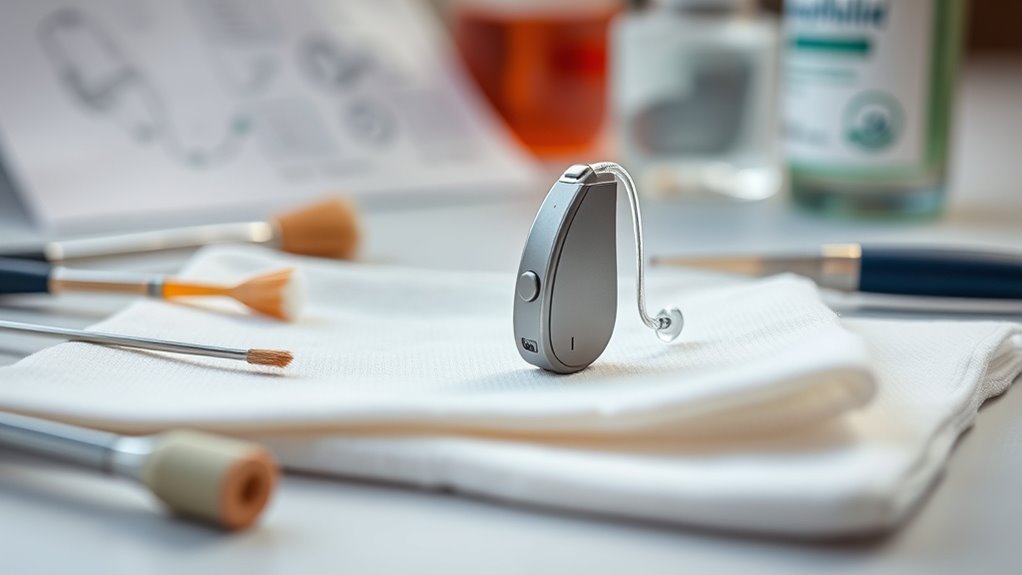
Proper care and cleaning are essential to keep your hearing aids functioning at their best. Regular earwax removal helps prevent buildup that can block sound and damage components. Gently wipe your hearing aids daily with a soft, dry cloth to remove dirt and moisture. Avoid using water or harsh chemicals, which can harm the device. Keep your ears healthy by maintaining good ear health practices—don’t insert objects into your ears, and consult your audiologist if you notice excessive wax. When not in use, store your hearing aids in a dry, safe place, ideally in a charging case or a designated container. Routine cleaning and earwax removal extend your device’s lifespan and guarantee ideal performance every day.
Communication Strategies and Listening Tips

Effective communication is essential for making the most of your hearing aids. To improve your listening skills, focus on active listening, which involves fully engaging with conversations and minimizing distractions. Recognizing verbal cues helps you interpret messages more accurately. Practice these strategies:
Engage fully in conversations, minimize distractions, and recognize verbal cues for better hearing aid communication.
- Maintain eye contact to stay engaged
- Use verbal cues like “I see” or “got it” to show understanding
- Minimize background noise whenever possible
- Ask for clarification if you don’t understand something
- Focus on key words and context during conversations
Support Resources and Follow-Up Care

Having strong communication strategies is just one part of successfully adapting to your hearing aids; ongoing support resources and follow-up care guarantee you get the most from your devices. Peer support groups connect you with others who understand your experiences, offering encouragement and practical advice. Community resources, such as local audiology clinics or hearing loss organizations, provide ongoing assistance, troubleshooting, and educational materials. Regular follow-up appointments ensure your hearing aids are functioning correctly and allow adjustments for peak performance. These resources help you stay motivated and confident as you adapt. By engaging with peer support and community programs, you create a network that empowers you to manage your hearing health proactively and maximize the benefits of your hearing aids.
Frequently Asked Questions
How Do I Adjust My Hearing Aid for Different Environments?
When you want to adjust your hearing aid for different environments, start by identifying the environmental settings you’re in. Use your device’s adjustment techniques, like changing the program mode or volume, to optimize sound quality. For noisy places, switch to a setting that reduces background noise. In quiet areas, increase volume slightly. Familiarize yourself with these adjustments so you can quickly adapt your hearing aid for any environment.
What Should I Do if My Hearing Aid Causes Discomfort?
If your hearing aid causes ear discomfort, don’t ignore it. First, remove the device and check for ear discomfort or irritation. Use troubleshooting tips like cleaning the hearing aid or adjusting the fit. If discomfort persists, consult your audiologist to guarantee proper fit and settings. Ignoring discomfort can lead to further issues, so seek professional advice promptly to ensure your hearing aid is comfortable and effective.
Are There Specific Foods or Habits That Affect Hearing Aid Performance?
Think of your hearing aid as a delicate garden that needs careful tending. Diet impacts and lifestyle habits can influence its performance—excess salt, caffeine, or smoking might clog your device’s functioning, just like weeds. Staying hydrated, eating balanced meals, and avoiding habits like smoking help keep your hearing aids working smoothly. Good habits nurture better sound quality and comfort, ensuring your hearing aid remains a trusted part of your daily life.
How Can I Prevent Theft or Loss of My Hearing Aid?
To prevent hearing aid theft and loss, you should take proactive steps. Always store your device in a secure place when not in use, and avoid leaving it in visible or unsecured spots. Use a clip or lanyard to keep it close, and consider investing in a theft prevention device. Being vigilant and mindful of your hearing aid’s whereabouts helps with hearing aid theft prevention and hearing aid loss prevention, ensuring your device stays safe.
What Are the Signs That My Hearing Aid Needs Professional Servicing?
Your hearing aid might be crying out for help if you notice reduced sound quality, unexpected whistling, or if it suddenly stops working. These signs mean it’s time for professional servicing, including hearing aid cleaning and battery replacement. Don’t ignore these signals—think of them as your device’s way of saying, “Help me stay in tune.” Regular check-ups keep your hearing aid performing at its best and extend its lifespan.
Conclusion
With proper practice and patience, your hearing aid becomes a powerful partner in your hearing journey. By mastering maintenance, managing settings, and seeking support, you’ll create a confident, comfortable connection to clearer communication. Embrace each element—handling, troubleshooting, and tuning—like a skilled craftsman shaping a masterpiece. Remember, consistent care and communication cultivate a confident, connected community, turning everyday experiences into empowering encounters. Your hearing health hinges on your hands—handle it with care and commitment.










